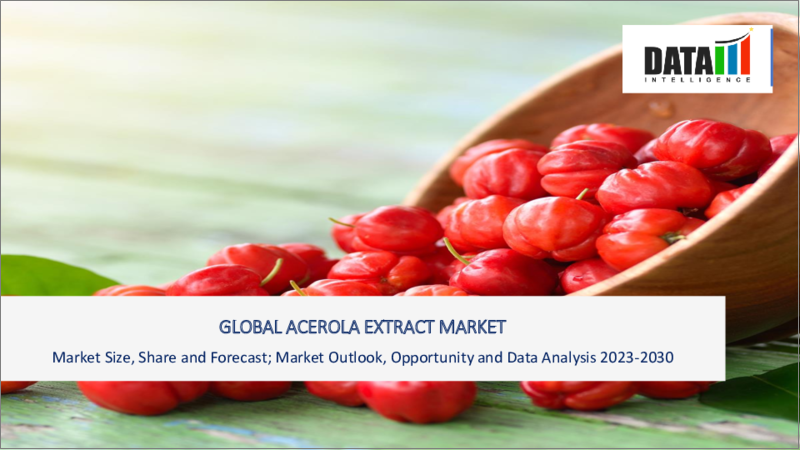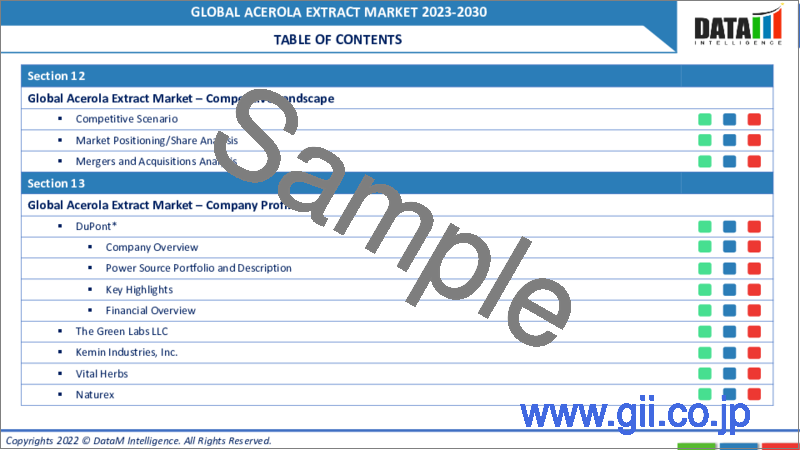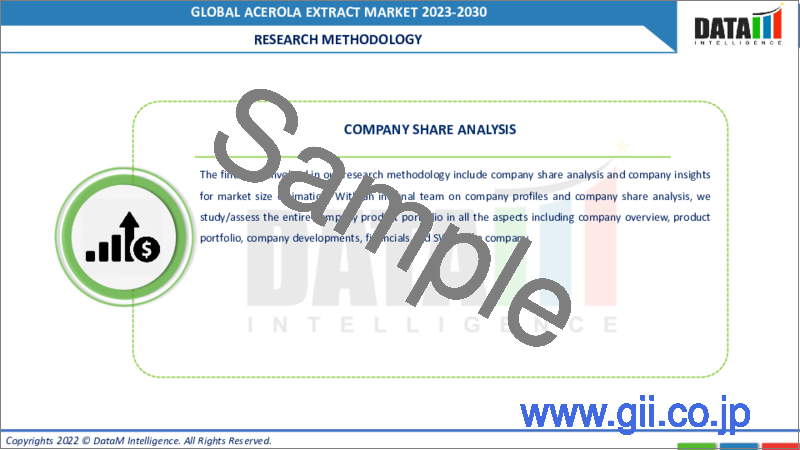|
|
市場調査レポート
商品コード
1117935
アセロラエキスの世界市場(2022年~2029年)Global Acerola Extract Market - 2022-2029 |
||||||
|
● お客様のご希望に応じて、既存データの加工や未掲載情報(例:国別セグメント)の追加などの対応が可能です。 詳細はお問い合わせください。 |
|||||||
| アセロラエキスの世界市場(2022年~2029年) |
|
出版日: 2022年08月22日
発行: DataM Intelligence
ページ情報: 英文 170 Pages
納期: 約2営業日
|
- 全表示
- 概要
- 目次
世界のアセロラエキス市場は、アセロラエキスの健康効果と認知度の向上により、成長が促進されています。
当レポートでは、世界のアセロラエキス市場について調査分析し、市場力学、セグメント分析、地域分析、競合情勢などを提供しています。
目次
第1章 範囲と調査手法
第2章 主な動向と発展
第3章 エグゼクティブサマリー
第4章 市場力学
- 市場に影響を与える要因
- 促進要因
- 抑制要因
- 機会
- 影響分析
第5章 業界分析
- ポーターのファイブフォース分析
- バリューチェーン分析
- 特許分析
- 規制分析
第6章 COVID-19分析
- 市場におけるCOVID-19の分析
- COVID-19前の市場シナリオ
- 現在のCOVID-19市場シナリオ
- COVID-19後または将来のシナリオ
- COVID-19中の価格変動
- 需給スペクトル
- パンデミック中の市場に関連する政府のイニシアチブ
- メーカーの戦略的イニシアチブ
第7章 形態別
- 乾燥
- 液体
第8章 性質別
- 従来型
- オーガニック
第9章 用途別
- 肉製品
- ベーカリー製品
- 菓子類
- 乳製品・冷凍デザート
- 飲料
- その他
第10章 地域別
- 北米
- 米国
- カナダ
- メキシコ
- 南米
- ブラジル
- アルゼンチン
- その他の南米
- 欧州
- ドイツ
- 英国
- フランス
- スペイン
- イタリア
- その他の欧州
- アジア太平洋
- 中国
- インド
- 日本
- オーストラリア
- その他のアジア太平洋
- 中東・アフリカ
第11章 競合情勢
- 競合シナリオ
- 競合企業の戦略分析
- 市場ポジショニング/シェア分析
- 合併と買収の分析
第12章 企業プロファイル
- DuPont
- The Green Labs LLC
- Kemin Industries, Inc.
- Vital Herbs
- Naturex
- DSM
- Martin Bauer Group
- Dohler GmbH
- Foodchem International Corporation
- Niagro Nichirei Group Company
第13章 DataM
Market Overview
Acerola extract market was valued at USD XX million in 2021. It is forecasted to reach USD XX million by 2029, growing at a CAGR of 7.2% during the forecast period (2022-2029).Acerola is a small tree or shrub. Acerola is also known as the Barbados cherry or West Indian cherry. Acerola is enjoyed as a juice, supplement or powder. Dry acerola extract is less perishable than the fresh fruit. Acerola is a rich source of vitamin C hence known as a superfood. Acerola is also a rich source of vitamins and minerals, including beta-carotene, lutein, thiamine, riboflavin, niacin, pyridoxine, folic acid, and pantothenic acid. Acerola extract is used for the cold, diarrhea, and other conditions. It contains high amount of ascorbic acid and anthocyanin content. Acerola fruit contains vitamins A, B1, B2, and B3, carotenoids, and bioflavonoids, which provide high nutrition value to body. Acerola is used in meat for color protection in fresh meat.
Market Dynamics:
Increasing health benefits and awareness of the acerola extract drive the market growth
Acerola is a rich source of Vitamin C. It is mostly used for Vitamin C deficiency. Vitamin C is used for collagen production, one of the key structural proteins in hair, skin and nails. Acerola extract provides Vitamin C in its natural form. Vitamin C can help cure colds and viruses up to 20% quicker. Vitamin C intake stimulates the production of multiple immune cells, including Lymphocytes, Phagocytes and T-Cells. It is helpful for hydrating the skin by inhibiting trans epidermal water loss. Anti-inflammatory properties of the acerola extract help to reduce skin redness and improve firmness and complexion. Acerola extract has immune-boosting properties that help to fight off the common cold and flu. It is a rich source of phytonutrients, including carotenoids, phenolic, flavonoids, and anthocyanin, as well as the minerals iron, phosphorus, and calcium. They are helpful for the support optimal immune function. Daily consumption of acerola extract help to improve brain health. Due to the anthocyanin, which acts as neuroprotective. It helps to protect the brain from damaging oxidative stress caused by compounds named free radicals. The high level of anthocyanin in acerola extract can reduce the risk of memory loss and associated cognitive decline. Acerola extract reduce inflammation and oxidation in the brain, which keeps brain cells and neurons healthy. It has various health benefits such as an antidepressant and antifungal and is widely used for athletic endurance, diarrhea, dysentery and skin astringent.
Market Segmentation:
Dry segment accounted for the highest share in global acerola extract market
In 2021, dry segment had the highest revenue share of over XX percent. The dry form of Acerola extract is considered powder. Acerola cherry extract powder is available in different packaging sizes and various brands. It is helpful as an immunity booster. Acerola extract is rich in vitamins A, B1, B2, C and B3, carotenoids and bioflavonoids, proteins, lipids, carbohydrates, calcium, phosphorus, iron, pyridoxine, riboflavin, thiamine, and dietary fiber. It also has antioxidant properties. The powder is easy to use and used as additives to shakes, smoothies, and meals. The dry powder form of the acerola extract has less moisture content, which increases the shelf life of the powder. Owing to this factor, it is highly preferred by manufacturers.
Organic acerola extract has high demand from consumers. The organic food consumption trend is increasing day by day. Manufacturers help farmers to grow organic cultivation of the Acerola. Manufacturers provide proper knowledge and help them get certified for their produce. Organic acerola farming is free from Synthetic chemical fertilizers, insecticides, herbicides, and other inputs. So, it doesn't have any disadvantages on the body.
Geographical Penetration:
North America is the dominating region during the forecast period
In 2021, North America is expected to generate the highest market share in the forecast period. Increasing demand for acerola extract in processed fish, meat and egg products. Consumers used acerola extract instead of sodium erythorbate due to the best result of extract. The US is the first country to use acerola extract in its NPL. It helps to prevent oxidation and maintain the organoleptic properties while increasing shelf-life. Increasing demand for acerola extract in the country tends to increase the import of acerola extract. The USA imported acerola extract from India due to high demand. Increasing health awareness of healthy dietary habits among consumers in the region. Some factors that increase the demand for acerola extract are demand for natural products, cost affordability, and the growing startups in the acerola extract market. US and Canada are the major countries in the region, which have a high consumption of meat and bakery products, respectively. The rising meat and bakery industry in the North America region is expected to drive market growth.
Competitive Landscape:
There are several established participants in the industry and local manufacturers; hence, the market is fragmented. Some major market players are DuPont, The Green Labs LLC, Kemin Industries, Inc., Vital Herbs, Naturex, DSM, Martin Bauer Group, Dohler GmbH, and Foodchem International Corporation among others. Some of the major key players launched new products to increase their product portfolio and sales. For instance, in March 2021, Kalsec launched DuraShield Natural Food Protection Blends new antimicrobial solution to improve shelf life and food safety. This product has applications including meat and poultry, deli salads, dips, sauces, and dressings. This product protects against protecting against microbial growth that causes spoilage, off-flavors and common foodborne pathogens, including but not limited to Listeria and Salmonella. This new product is a blend of rosemary and acerola extracts. In April 2021, Kemin Food Technologies Launched Ingredient Library. The ingredient library showcases the Kemin ingredient solutions, including Acerola: a label-friendly, multi-purpose ingredient that can be used as a cure accelerator in alternatively cured meats and even offers color protection in fresh meat products. In January 2020, CAIF launched acerola powder extract with a minimum of 32% native vitamin C. That extract is used as supplements, beverages, and snacks. In February 2019, Hamburg-based fruit ingredient specialist Bosch Boden Spies, together with its brand partner 2005 Niagro, launched a new product, acerola puree, made from the acerola cherry, with 25 percent more vitamin C.
COVID-19 Impact:
Positive impact on the global acerola extract market
As acerola extract is a rich source of vitamin C with immunity-boosting properties also acts as powerful antioxidant protection against damage, including oxidative stress and systemic infection. Vitamin C is also known for its usefulness in preventive respiratory distress syndrome; it has been used successfully in treating the same. Doctors and nutritionists suggest consuming Vitamin C-rich fruits and vegetables and supplements in adequate quantities. Some studies stated that incorporating Vitamin C speeds up the recovery of coronavirus disease. Doctors and nutritionists suggested the consumption of vitamin C-rich fruits like bell peppers, guava, kiwi, papaya, mango, amla and Acerola berries. Vitamin C has prevented and alleviated viral and bacterial infections. Vitamin C has been shown to help reduce the severity of cold and flu illnesses in some trials, though experts widely debate this finding. The vitamin's effect is also significantly less than many might expect. These are some factors that positively impacted on the market.
The global acerola extract market report would provide an access to approximately 61 market data tables, 53 figures and 170 pages
Table of Contents
Scope and Methodology
- 1.1. Research Methodology
- 1.2. Scope of the Market
2. Key Trends and Developments
3. Executive Summary
- 3.1. Market Snippet by Form
- 3.2. Market Snippet by Nature
- 3.3. Market Snippet by Application
- 3.4. Market Snippet by Region
4. Market Dynamics
- 4.1. Market impacting factors
- 4.1.1. Drivers
- 4.1.2. Restraints
- 4.1.3. Opportunities
- 4.2. Impact analysis
5. Industry Analysis
- 5.1. Porter's five forces analysis
- 5.2. Value chain analysis
- 5.3. Patent Analysis
- 5.4. Regulatory Analysis
6. COVID-19 Analysis
- 6.1. Analysis of Covid-19 on the Market
- 6.1.1. Before COVID-19 Market Scenario
- 6.1.2. Present COVID-19 Market Scenario
- 6.1.3. After COVID-19 or Future Scenario
- 6.2. Pricing Dynamics Amid Covid-19
- 6.3. Demand-Supply Spectrum
- 6.4. Government Initiatives Related to the Market During Pandemic
- 6.5. Manufacturers Strategic Initiatives
7. By Form
- 7.1. Introduction
- 7.1.1. Market size analysis, and y-o-y growth analysis (%), By Form Segment
- 7.1.2. Market attractiveness index, By Form Segment
- 7.2. Dry *
- 7.2.1. Introduction
- 7.2.2. Market Size Analysis, US$ Million, 2020-2029 And Y-O-Y Growth Analysis (%), 2021-2029
- 7.3. Liquid
8. By Nature
- 8.1. Introduction
- 8.1.1. Market size analysis, and y-o-y growth analysis (%), By Nature Segment
- 8.1.2. Market attractiveness index, By Nature Segment
- 8.2. Conventional *
- 8.2.1. Introduction
- 8.2.2. Market Size Analysis, US$ Million, 2020-2029 And Y-O-Y Growth Analysis (%), 2021-2029
- 8.3. Organic
9. By Application
- 9.1. Introduction
- 9.1.1. Market size analysis, and y-o-y growth analysis (%), By Application Segment
- 9.1.2. Market attractiveness index, By Application Segment
- 9.2. Meat Products *
- 9.2.1. Introduction
- 9.2.2. Market Size Analysis, US$ Million, 2020-2029 And Y-O-Y Growth Analysis (%), 2021-2029
- 9.3. Bakery Products
- 9.4. Confectioneries
- 9.5. Dairy & Frozen Desserts
- 9.6. Beverages
- 9.7. Others
10. By Region
- 10.1. Introduction
- 10.1.1. Market Size Analysis, And Y-O-Y Growth Analysis (%), By Region
- 10.1.2. Market Attractiveness Index, By Region
- 10.2. North America
- 10.2.1. Introduction
- 10.2.2. Key region-specific dynamics
- 10.2.3. Market Size Analysis, And Y-O-Y Growth Analysis (%), By Form
- 10.2.4. Market Size Analysis, And Y-O-Y Growth Analysis (%), By Nature
- 10.2.5. Market Size Analysis, And Y-O-Y Growth Analysis (%), By Application
- 10.2.6. Market Size Analysis, And Y-O-Y Growth Analysis (%), By Country
- 10.2.6.1. U.S.
- 10.2.6.2. Canada
- 10.2.6.3. Mexico
- 10.3. South America
- 10.3.1. Introduction
- 10.3.2. Key Region-Specific Dynamics
- 10.3.3. Market Size Analysis, And Y-O-Y Growth Analysis (%), By Form
- 10.3.4. Market Size Analysis, And Y-O-Y Growth Analysis (%), By Nature
- 10.3.5. Market Size Analysis, And Y-O-Y Growth Analysis (%), By Application
- 10.3.6. Market Size Analysis, And Y-O-Y Growth Analysis (%), By Country
- 10.3.6.1. Brazil
- 10.3.6.2. Argentina
- 10.3.6.3. Rest of South America
- 10.4. Europe
- 10.4.1. Introduction
- 10.4.2. Key Region-Specific Dynamics
- 10.4.3. Market Size Analysis, And Y-O-Y Growth Analysis (%), By Form
- 10.4.4. Market Size Analysis, And Y-O-Y Growth Analysis (%), By Nature
- 10.4.5. Market Size Analysis, And Y-O-Y Growth Analysis (%), By Application
- 10.4.6. Market Size Analysis, And Y-O-Y Growth Analysis (%), By Country
- 10.4.6.1. Germany
- 10.4.6.2. U.K.
- 10.4.6.3. France
- 10.4.6.4. Spain
- 10.4.6.5. Italy
- 10.4.6.6. Rest of Europe
- 10.5. Asia Pacific
- 10.5.1. Introduction
- 10.5.2. Key Region-Specific Dynamics
- 10.5.3. Market Size Analysis, And Y-O-Y Growth Analysis (%), By Form
- 10.5.4. Market Size Analysis, And Y-O-Y Growth Analysis (%), By Nature
- 10.5.5. Market Size Analysis, And Y-O-Y Growth Analysis (%), By Application
- 10.5.6. Market Size Analysis, And Y-O-Y Growth Analysis (%), By Country
- 10.5.6.1. China
- 10.5.6.2. India
- 10.5.6.3. Japan
- 10.5.6.4. Australia
- 10.5.6.5. Rest of Asia Pacific
- 10.6. Middle East and Africa
- 10.6.1. Introduction
- 10.6.2. Key Region-Specific Dynamics
- 10.6.3. Market Size Analysis, And Y-O-Y Growth Analysis (%), By Form
- 10.6.4. Market Size Analysis, And Y-O-Y Growth Analysis (%), By Nature
- 10.6.5. Market Size Analysis, And Y-O-Y Growth Analysis (%), By Application
11. Competitive Landscape
- 11.1. Competitive scenario
- 11.2. Competitor strategy analysis
- 11.3. Market positioning/share analysis
- 11.4. Mergers and acquisitions analysis
12. Company Profiles
- 12.1. DuPont*
- 12.1.1. Company Overview
- 12.1.2. Product Portfolio and Description
- 12.1.3. Key Highlights
- 12.1.4. Financial Overview
- 12.2. The Green Labs LLC
- 12.3. Kemin Industries, Inc.
- 12.4. Vital Herbs
- 12.5. Naturex
- 12.6. DSM
- 12.7. Martin Bauer Group
- 12.8. Dohler GmbH
- 12.9. Foodchem International Corporation
- 12.10. Niagro Nichirei Group Company
- List not Exhaustive*
13. DataM
- 13.1. Appendix
- 13.2. About us and services
- 13.3. Contact us




